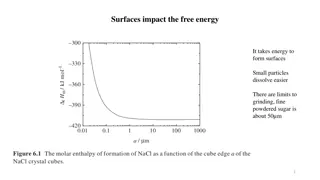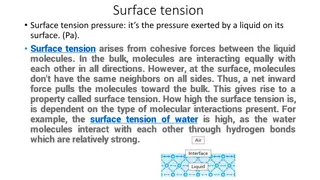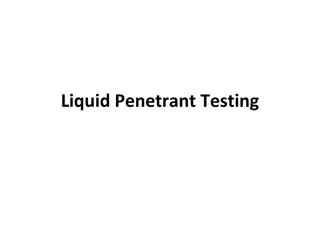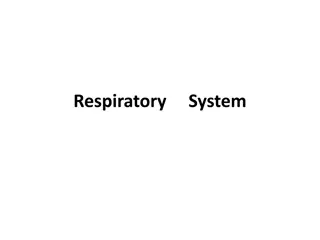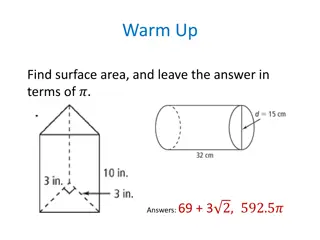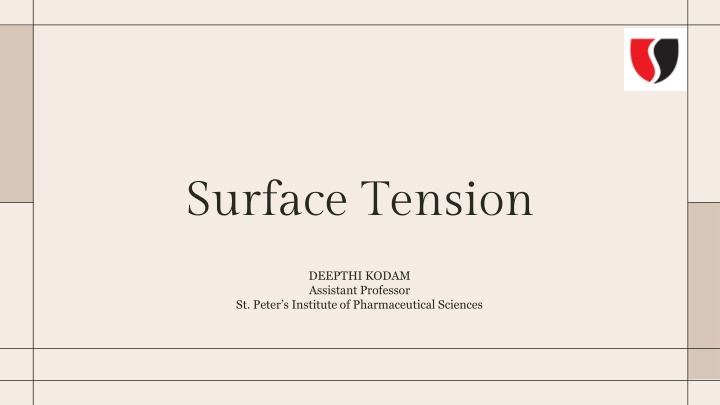
Understanding Surface Tension and Measurement Methods
Explore the concept of surface tension, its impact on liquids, and methods to measure it. Factors affecting surface tension and various determination methods like the capillary rise, Wilhelmy plate, and Du Nouy ring methods are discussed.
Download Presentation

Please find below an Image/Link to download the presentation.
The content on the website is provided AS IS for your information and personal use only. It may not be sold, licensed, or shared on other websites without obtaining consent from the author. If you encounter any issues during the download, it is possible that the publisher has removed the file from their server.
You are allowed to download the files provided on this website for personal or commercial use, subject to the condition that they are used lawfully. All files are the property of their respective owners.
The content on the website is provided AS IS for your information and personal use only. It may not be sold, licensed, or shared on other websites without obtaining consent from the author.
E N D
Presentation Transcript
Surface Tension DEEPTHI KODAM Assistant Professor St. Peter s Institute of Pharmaceutical Sciences
Introduction This presentation explores the concept of surface tension, its impact on liquids, and the various methods used to measure it.
Definition of Surface Tension Surface tension Surface tension is a Surface tension is a measurement of the cohesive energy present at an interface. The molecules of a liquid attract each other. The interactions of a molecule in the bulk of a liquid are balanced by an equal attractive force in all directions. Units of surface tension The SI unit of Surface Tension is Newton per Meter or N/m The CGS unit of surface tension is dyne/cm.
Factors Affecting Surface Tension Several factors influence surface tension, including Temperature (higher temperatures decrease surface tension), The presence of surfactants (which lower surface tension), and The type of liquid. Additionally, significantly alter surface tension properties. impurities and additives can also
02 Determination Methods
Capillary Rise Method In the capillary rise method, a thin tube is inserted into a liquid. Due to surface tension, the liquid climbs the tube's walls, and the height of this rise is measured. The surface tension can be calculated using the height of the liquid column, diameter of the tube, and fluid density. This method is straightforward and commonly used in laboratories.
Wilhelmy Plate Method The Wilhelmy plate method involves immersing a thin, vertically oriented plate into a liquid. The force exerted by the liquid on the plate,measured using a balance, will provide information about the surface tension. This technique is particularly useful for accurately measuring surface tension changes with temperature and surfactant concentration.
Du Nouy Ring Method The Du Nouy ring method measures the force required to detach a ring from the surface of a liquid. A ring made of a specific material is gently submerged in the liquid, and the force needed to pull it away is recorded. The surface tension calculated based on this force and the ring's dimensions, precise results for different liquid types. is then offering
Drop Count and Drop weight Method A stalagmometer is a device consisting of a capillary tube with a wide, bulb-shaped middle section and a narrow bottom that together allow a liquid to form a drop as it falls from the tube. It is used in a process known as the drop-weight method to compare the number and weight of drops of a particular liquid to a reference liquid, such as water. The instrument is used to measure a liquid's surface tension
Conclusions Understanding surface tension is essential in various scientific and practical fields. Its measurement methods, including the capillary rise, Wilhelmy plate, and Du No y ring methods, provide insights into physical properties of liquids. By manipulating surface tension, we can improve numerous ultimately enhancing product quality and performance. industrial processes,


